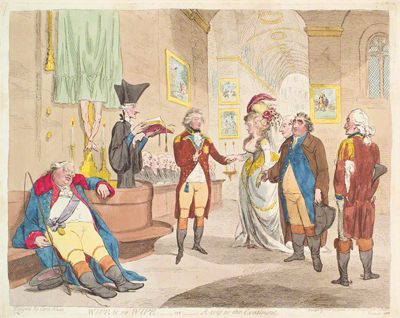Wife & No Wife...
In December 1785, the Prince of Wales (the future George IV) married a twice-widowed Catholic, Maria Fitzherbert, in a secret ceremony performed by one of the Prince's Chaplains in Ordinary in the drawing room of the bride's home in Park Lane. Her uncle and brother were witnesses. The marriage was conducted in violation of the recently passed Royal Marriages Act (1772) which forbade (and refused to recognize) any marriage by a royal family member entered into without the King's consent. And had the marriage been considered valid, the union would have disqualified the Prince from the succession by the provisions of the earlier Act of Settlement prohibiting marriage to Catholics.
It was not long, however, before rumors of the Prince's secret marriage began circulating, and the absence of any confirmed information provided a large and fertile field for the public imagination. Gillray's Wife & No Wife, or a Trip to the Continent [March 1786] is one such imagining.

© National Portrait Gallery, London
Gillray sets the scene in a Catholic Church on the continent. The wedding party consists of the usual opposition suspects. The crypto-Catholic Edmund Burke officiates as the Prince is about to put the ring on Mrs. Fitzherbert's finger. Fredrick Lord North with a coachman's coat and whip has fallen asleep after delivering the happy couple to the church. Since this has every evidence of being a hurried elopement, Charles James Fox has been acting in loco parentis giving the bride away. And two of the Prince's companions— Colonel George Hanger (between the bride and Fox) and Louis Weltje (acting as steward with celebratory bottles ready in his pockets)— are present as the only other witnesses.
The pictures on the wall provide a commentary on the major players. Next to the Prince is a picture of King David gazing down from the palace roof upon the then married Bathsheba. Like the Prince of Wales, David immediately becomes infatuated with her, and after some conniving (which God thoroughly disapproves), marries her. Next to Mrs. Fitzherbert are two scenes which assume (falsely) her role as temptress. The one closest to her prominent and mostly exposed breasts shows Eve offering Adam the apple as the serpent looks on. The second is generally believed to show St Anthony being tempted by a naked woman and assorted devils. Consistent with the royal family's view of Fox's insidious and dangerous influence, the picture next to Charles James Fox shows Judas Iscariot as he betrays Christ. And the entire print is supposedly "Designed by Carlo Khan" (a Fox allusion) to suggest that the entire secret marriage was engineered by Fox.
In fact, on December 10 1785, 10 days before the marriage, on hearing rumors of the Prince's intention, Fox had written a long and thoughtful letter describing the potential marriage as "a desperate step" and outlining the many objections to it both political and personal. Ironically, among them was the ambiguous status in which the Prince would be placing his avowed love, Mrs. Fitzherbert, who would be a wife and yet no wife. In his response to Fox's letter, the Prince denied any such intention and continued to keep Fox in the dark well after the marriage took place.
Two years later in 1788 when the question of paying off the Prince's debts was once again under discussion and the issue of his eligibility to succeed to the crown was a considerable factor in that discussion, this print and its companion, The Morning after Marriage, or a Scene on the Continent were re-issued. In both cases, copies show the publication date rather crudely changed from 1786 to 1788.
Coming after a couple of years in which Gillray had mostly devoted himself to "serious" engraving, and experimented with new techniques, Wife & No Wife... is perhaps the first and one of the best examples of the artistic preeminence Gillray was to bring to caricature in the ensuing years. The figures are beautifully and naturally arranged. The perspective and architecture are virtually flawless. And Gillray has perfected a variety of techniques to suggest light, shade, and contour including parallel and cross-hatched lines, and the use of stipple on the faces of the Prince, Mrs. Fitzherbert, and Fox. But it is also clear that he has returned the plate to the acid bath multiple times to create the several gradations of shade on the church floor and ceiling, and more subtly in the figures on the right half of the plate. The size of the print is much larger than most of his earlier caricatures and approaches that of Gillray's serious works—all of this suggesting that Gillray has come to recognize that political and social satire IS the serious artistic work of his career.
Sources and Reading
- Commentary from the British Museum on Wife & No Wife...
- "Royal Marriages Act 1772" Wikipedia
- Draper Hill, Fashionable Contrasts, 1966, #54
- John W. Derry, Charles James Fox
- "George IV of the United Kingdom," Wikipedia
- "Maria Fitzherbert," Wikipedia
Comments & Corrections
NOTE: Comments and/or corrections are always appreciated. To make that easier, I have included a form below that you can use. I promise never to share any of the info provided without your express permission.